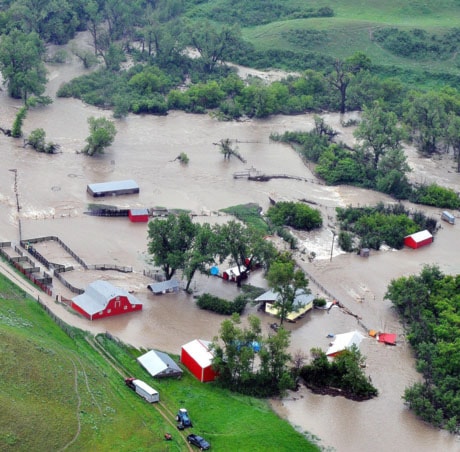Stranded residents had to be rescued from their flooded homes by boat and by helicopter Friday as torrential rains across the southern Prairies washed out rural roads and submerged the Trans-Canada Highway beneath rushing rivers of water.
Several communities declared states of emergency, including Maple Creek, Sask., where patients were evacuated from the town’s 10-bed hospital and residents from 75 homes had to flee.
“We have lost our fire truck, our rescue unit is in four feet of water,” Wayne Burton of the Salvation Army said Friday. “We went to rescue a couple of people in wheelchairs but the fire truck was up to the windshield in water. We had to use a rowboat to get those people out.”
In town after town, rivers and creeks surged over their banks, flooding main streets and neighbourhoods and turning the flat farmland into vast, muddy lakes.
“It’s devastating,” said RCMP Sgt. Duncan MacInnis as he looked out over flooded fields near Irvine, Alta. “It’s done a lot of damage to the town ... and a lot of ranches and farms. The water that’s going through the fields here now is going to end up somewhere on somebody’s property and cause more damage.”
About 20 homes were evacuated in the Irvine area.
“They actually had to helivac some people out of there because they got trapped. That’s what the fireman told me,” said James Thomey, whose own house was spared from flooding.
“There was water actually going through their windows, so there must be at least six feet of water.”
Some estimates indicated at least 150 millimetres of rain fell Thursday night and Friday morning. But Thomey said three weeks of heavy rain have saturated the ground, leaving the water nowhere to go but overland.
“It’s getting pretty bad,” he said. “I’m in a higher spot, and if you step out on my grass, it’s just like walking on water.”
County manager Lutz Pershon said he hadn’t seen anything like it in 31 years and confirmed some residents had to be rescued by boats or helicopter.
“Ross Creek has just rose unbelievably high in a short period of time,” said Pershon.
A teenager trying to get to Medicine Hat to take an exam narrowly escaped being swept away by the raging water when he tried to drive across a bridge.
Don Byspalko said the water was up to the headlights when the 17-year-old’s car started floating away.
“The only thing that stopped him was a fence and tree. And he was actually clinging to the tree when they did save him.”
Chantelle Schinkel awoke to find water lapping at her front door.
“We started grabbing as many things as we could and putting them in the car,” she said. “We grabbed our child, our dogs and started getting our neighbours out of their houses.”
“You work so hard for a lot of your things,” said Irvine resident Danny Gallagos. “You don’t learn how to appreciate things until something like this happens.”
For the second time in recent months, people were also out of their homes on the Blood reserve west of Lethbridge, Alta. Tribe spokesman Rick Tailfeathers said 41 homes had to be evacuated because of the rising St. Mary and Waterton rivers. About 140 homes had flooded basements and 20 had leaky roofs.
“Things aren’t good,” he said. “The infrastructure has been impacted drastically.”
Flooding closed the Trans-Canada Highway for several kilometres on both sides of the Alberta-Saskatchewan boundary, which forced motorists to take a 200-kilometre detour. About 5,000 vehicles use the stretch of highway every day.
“We’ve got water overtopping the road for a length of about three kilometres now,” said Kristen Leatherdale with the Saskatchewan Highways Ministry, noting that was just on the Saskatchewan side of the boundary.
“It’s pretty deep and it’s flowing heavy in spots ... we have had some flooding in the past but not to this extent in this area. Our staff who have been here for many, many years ... are pretty shocked to see what they’re seeing out there.”
For instance, one highway in Tantallon in the Qu’Appelle Valley has collapsed completely, dropping 2.1 metres in spots.
“It’s in hilly area and a big chunk of land has started to move,” said Leatherdale. “That’s impacted the highway, which has dropped several feet.”
Drivers were also being warned that heavy rain and flooding was disrupting travel on highways around Medicine Hat in southeastern Alberta. Highway 41 was closed from its junction with the Trans-Canada near Irvine to the United States border.
Karen Hamerton of the Irvine fire department said two evacuation centres had been set up for people forced out of their homes and who need a place to wait for a ride.
“Right now, the only way in or out of Irvine is through the back roads on the north side of the tracks,” she said.
The situation stranded about 17 truckers. Driver Jim Boyer said townspeople have been amazing, feeding them and finding them shelter.
In return, they helped sandbag and set up a pump at the local hotel.
“The people here are just absolutely fantastic ... It’s just a great, big happy community,” he said.
The heavy rain forced the closure of Cypress Hills Interprovincial Park on the Alberta-Saskatchewan boundary. The Saskatchewan Water Authority warned that the city of Swift Current was also threatened.
Environment Canada was forecasting a 60 per cent chance of more rain overnight Friday. But there was also a glimmer of optimism — sunny skies were predicted for Saturday and Sunday.
In Manitoba, already-sodden ground was showered with another 150 millimetres or more of rain in some areas.
Reeve Edward Levandoski of the Rural Municipality of Rosedale, north of Neepawa in western Manitoba, said it was still coming down Friday and was expected to continue Saturday.
“We have numerous culverts and bridges washed out,” he said. “The men are busy identifying these spots and putting up barricades and warning flags.”
